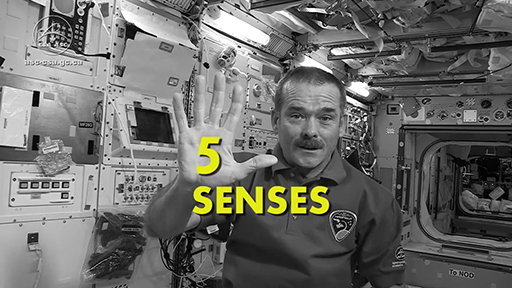4 Reducing the effects of ageing in a microgravity environment
You’ve seen how living in a microgravity environment affects the blood pressure, heart and vision of an astronaut. But how does this environment affect the other senses? Watch Video 2 to see.

Transcript: Video 2 Hearing in space.
How else does living in a microgravity environment affect the health of an astronaut? Bones and muscles are then weakened further by the reduced effects of Earth’s gravity in a microgravity environment. However, the ‘flip side’ is that prolonged stays in microgravity environments also affect astronauts’ balance, posture and coordination.
Can hormones, drugs and surgical intervention prevent bone loss or encourage bone formation? In the 1940s, Russian scientists developed a surgical technique for promoting bone growth. They found that inserting screws into the bones and gradually forcing the bones apart promotes bone growth (Figure 5).
Such a procedure is a bit extreme for astronauts on board the ISS though! Instead, astronauts need to follow a strict physical regime, devoting at least two hours per day to excercise.
What kind of exercises would help to reduce bone and muscle loss? Due to the effects of microgravity, some activities are much easier on the ISS than on Earth: for example, weightlifting. This means that exercise equipment has to be designed specifically to be used in space. You can discover more on this website: www.nasa.gov/ audience/ foreducators/ stem-on-station/ ditl_exercising [Tip: hold Ctrl and click a link to open it in a new tab. (Hide tip)]
Figure 6 shows NASA astronaut Karen Nyberg using the rather exotically named Advanced Resistive Exercise Device (ARED) (weightlifting equipment) on board the ISS. How do you think this has been adapted for use in space?
Weightlifting is not the only exercise that astronauts can do. They can even run marathons on the ISS. The main adaptation for space use is a harness which attaches the runner to the treadmill (see Figure 7). Here, in 2007, NASA astronaut Sunita Williams completed the first marathon in orbit around the Earth. She ran as an entrant in the Boston Marathon in a respectable time of 4 hours and 24 minutes.
Now complete Activity 4 which focuses on marathon distances, times and speeds.
Note: some values will need to be rounded to the appropriate number of significant figures. The ‘trick’ here is to look carefully at the number given by your calculation, for example 123 552. If you needed to round this to 2 significant figures, look at the second digit in this number. Here it is 2. The digit immediately after this is 3. As this digit is 4 or less, you leave it alone. If it is between 5 and 9, you round up the previous digit. In the case of 123 552, to 2 significant figures, this would be rounded down to 120 000.
If the value was 7777.77, to 2 significant figures and because the third digit is 7, it would be rounded up to 7800.
Activity 4 Running a marathon
Answer the following questions by choosing the one correct option for each.
a.
42 metres
b.
420 metres
c.
4200 metres
d.
42 000 metres
e.
420 000 metres
The correct answer is d.
a.
26.4 seconds
b.
264 seconds
c.
1584 seconds
d.
2640 seconds
e.
15 840 seconds
The correct answer is e.
a.
0.78 m/s
b.
7.8 m/s
c.
78 m/s
d.
7800 m/s
e.
780 000 m/s
The correct answer is d.
a.
0.12 km
b.
12 km
c.
120 km
d.
1200 km
e.
120 000 km
The correct answer is e.
You will now look at how NASA used an innovative approach to consider how the ageing process affected their astronauts.



